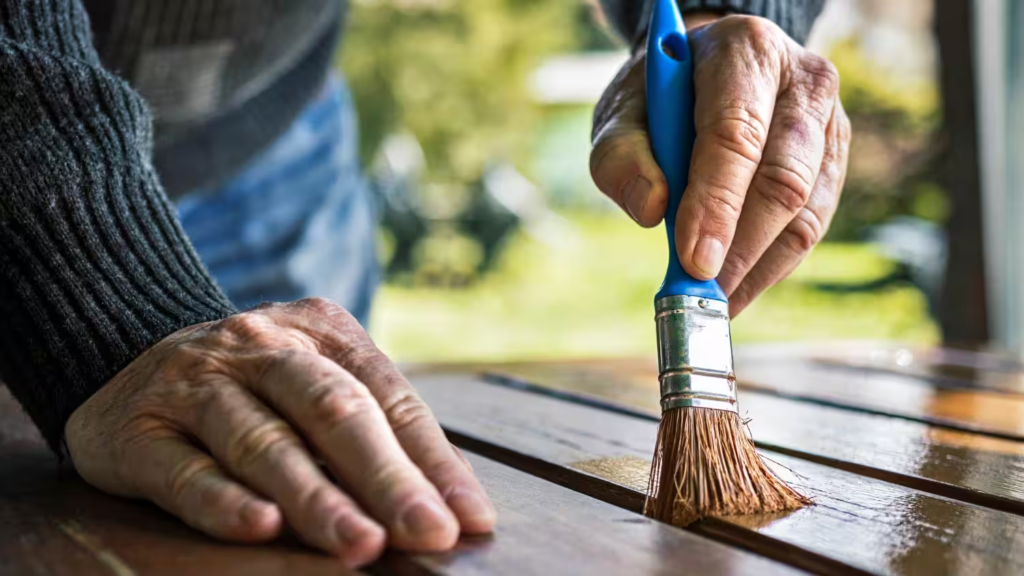Wood, although a versatile and aesthetically pleasing material, is vulnerable to water damage. Exposure to moisture can cause wood to swell, warp, rot, and attract pests. To prolong the lifespan of wooden surfaces and maintain their structural integrity, it is crucial to apply a waterproofing paint. This article will delve into the benefits of waterproofing paint, the application process, and frequently asked questions about this protective coating.

Benefits of Waterproofing Paint for Wood Surfaces
Waterproofing paint offers numerous advantages when applied to wood surfaces, including:
-
Protection against water damage: The primary benefit of waterproofing paint is its ability to create a barrier that prevents water penetration. It acts as a shield, safeguarding the wood against moisture, thereby minimizing the risk of rot, warping, and decay.
-
Enhanced durability: Waterproofing paint reinforces the wood’s natural durability, making it more resistant to wear and tear. It provides an added layer of protection against UV rays, preventing discoloration and degradation caused by prolonged sun exposure.
-
Prevention of mold and mildew: By inhibiting water penetration, waterproofing paint discourages the growth of mold and mildew. These fungi thrive in damp environments, and their presence not only affects the appearance but also poses health risks to inhabitants.
-
Improved aesthetics: Waterproofing paint is available in a wide range of colors and finishes, allowing you to enhance the appearance of wood surfaces. By adding a decorative touch, waterproofing paint can revive worn-out structures and create a visually appealing finish.
Application Process
To ensure the effective application of waterproofing paint on wood surfaces, follow these steps:
-
Surface preparation: Start by cleaning the wood surface thoroughly, removing any dirt, dust, or loose fibers. Sanding the surface will help smoothen any rough areas and promote better paint adhesion.
-
Priming the surface: Before applying the waterproofing paint, it is recommended to apply a primer specially formulated for wood. Primer helps the paint adhere better, creates a more even finish, and improves the paint’s durability.
-
Selecting the waterproofing paint: Choose a high-quality waterproofing paint specifically designed for wood surfaces. Look for a paint that provides maximum moisture protection and is suitable for the intended application, whether it’s outdoor furniture, decks, fences, or other wooden structures.
-
Applying the paint: Use a high-quality brush or roller to apply an even coat of waterproofing paint on the wood surface. Follow the manufacturer’s instructions regarding the recommended number of coats and drying time between each coat. Ensure that the paint is applied evenly to avoid drips or uneven coverage.
-
Maintenance: Regularly inspect the painted wood surfaces for signs of wear or damage. Touch up any areas that show signs of flaking or peeling to maintain the integrity of the waterproofing paint and its protective function.
FAQs about Waterproofing Paint on Wood Surfaces
Q: Can I use any type of paint for waterproofing wood surfaces?
A: No, it is essential to choose a paint specifically formulated for waterproofing wood. These paints are designed to resist water penetration and offer protection against moisture-related issues.
Q: How long does waterproofing paint last on wood surfaces?
A: The longevity of waterproofing paint largely depends on various factors, including the quality of the paint, environmental conditions, and the level of maintenance. Generally, high-quality waterproofing paint can provide protection for several years but may require periodic touch-ups.
Q: Can I apply waterproofing paint over existing paint or stain?
A: It is generally recommended to remove any existing paint or stain before applying waterproofing paint. This ensures better adhesion and allows the waterproofing paint to penetrate the wood surface effectively.
Q: Is it necessary to primer the wood before applying waterproofing paint?
A: While not always mandatory, priming the wood surface before applying waterproofing paint can enhance the paint’s adhesion, durability, and overall finish. It is advisable to consult the manufacturer’s guidelines regarding the use of a primer for the specific type of waterproofing paint you intend to use.
Conclusion
Applying waterproofing paint to wood surfaces is crucial to protect them from water damage, preserve their aesthetics, and extend their lifespan. By creating a protective barrier, waterproofing paint prevents moisture penetration, decay, and the growth of mold and mildew. The application process involves surface preparation, priming, selecting the right paint, and applying it evenly. Regular maintenance and periodic touch-ups will ensure long-lasting protection. Take the necessary precautions to choose the right paint and follow the recommended application process to enjoy the benefits of waterproofing paint on your wood surfaces.
